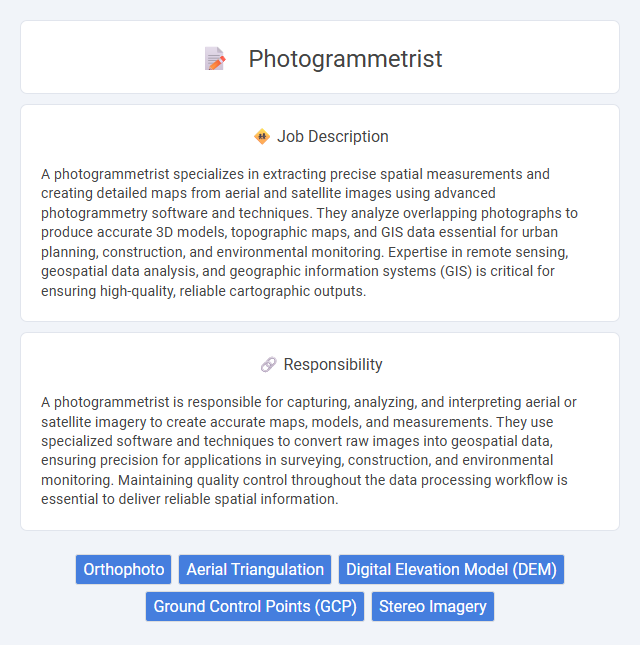
A photogrammetrist specializes in extracting precise spatial measurements and creating detailed maps from aerial and satellite images using advanced photogrammetry software and techniques. They analyze overlapping photographs to produce accurate 3D models, topographic maps, and GIS data essential for urban planning, construction, and environmental monitoring. Expertise in remote sensing, geospatial data analysis, and geographic information systems (GIS) is critical for ensuring high-quality, reliable cartographic outputs.
Individuals with strong attention to detail and an interest in technology are likely to be well-suited for a photogrammetrist job. Those who enjoy working independently and have good spatial awareness may find this role engaging and fulfilling. Conversely, people uncomfortable with prolonged computer work or complex data analysis might struggle to thrive in this position.
Qualification
A Photogrammetrist requires a strong background in geomatics, surveying, or a related field, typically holding a bachelor's degree in geomatics engineering, geography, or earth sciences. Proficiency in photogrammetry software such as Pix4D, Agisoft Metashape, and GIS tools is essential for processing aerial images and generating accurate 3D models. Advanced skills in spatial data analysis, remote sensing, and precise measurement techniques are critical to ensure accurate mapping and geographic information system integration.
Responsibility
A photogrammetrist is responsible for capturing, analyzing, and interpreting aerial or satellite imagery to create accurate maps, models, and measurements. They use specialized software and techniques to convert raw images into geospatial data, ensuring precision for applications in surveying, construction, and environmental monitoring. Maintaining quality control throughout the data processing workflow is essential to deliver reliable spatial information.
Benefit
Working as a photogrammetrist likely offers benefits such as the opportunity to engage with cutting-edge technology in 3D mapping and spatial data analysis, which may enhance technical skills and career growth prospects. The role probably includes a strong demand for expertise in various industries like surveying, construction, and environmental monitoring, suggesting job stability and diverse project experiences. Furthermore, photogrammetrists might enjoy competitive salaries and the chance to contribute to innovative projects that impact urban planning and resource management.
Challenge
A Photogrammetrist likely faces the challenge of accurately interpreting and processing complex aerial or satellite imagery to create precise maps and 3D models. The role probably demands advanced skills in image analysis software and a strong understanding of geospatial data to ensure measurement accuracy. Managing large datasets while maintaining accuracy under tight deadlines could be a common difficulty in this field.
Career Advancement
Photogrammetrists leverage advanced imaging technologies to create precise maps and 3D models from aerial and satellite photographs, making their expertise crucial in geography, construction, and environmental monitoring. Career advancement opportunities include moving into senior technical roles, project management, or specialized fields such as remote sensing and geospatial data analysis. Earning certifications like Certified Photogrammetrist (ASPRS) and gaining proficiency in software like ERDAS IMAGINE and Agisoft Metashape significantly enhance promotion prospects and earning potential.
Key Terms
Orthophoto
Photogrammetrists specialize in creating highly accurate orthophotos by processing aerial and satellite imagery through advanced software applications like Agisoft Metashape and Pix4D. Orthophotos, corrected for lens distortion and terrain relief, are essential for precise mapping, land surveying, and urban planning projects, providing geospatial data with true scale representation. Mastery of geographic information systems (GIS) integration and drone technology enhances the quality and applicability of orthophoto products in various industries.
Aerial Triangulation
A photogrammetrist specializing in aerial triangulation processes overlapping aerial images to establish accurate ground control points and create precise 3D spatial data. They utilize advanced software and GPS data to correct image distortions and ensure georeferencing accuracy for mapping and surveying projects. This role is crucial in producing reliable topographic maps, urban planning models, and infrastructure monitoring systems.
Digital Elevation Model (DEM)
Photogrammetrists specialize in creating precise Digital Elevation Models (DEMs) by analyzing aerial imagery and satellite data to produce accurate 3D representations of terrain. They utilize advanced software and geographic information systems (GIS) to extract elevation information critical for land surveying, urban planning, and environmental monitoring. Expertise in DEM generation enhances the accuracy of topographic maps and supports infrastructure development and disaster management projects.
Ground Control Points (GCP)
A Photogrammetrist specializes in capturing and analyzing aerial images to create accurate geospatial data, with a crucial focus on Ground Control Points (GCP) for precise georeferencing. Ground Control Points are surveyed locations on the Earth's surface with known coordinates, essential for correcting and validating aerial or satellite imagery in photogrammetric projects. Accurate GCP collection enhances the spatial accuracy of 3D models, maps, and orthophotos produced by photogrammetrists, making them vital for surveying, construction, and environmental monitoring.
Stereo Imagery
A Photogrammetrist specializing in stereo imagery utilizes overlapping aerial or satellite photographs to create precise 3D models and maps. Expertise in interpreting stereo pairs enables accurate extraction of elevation data and spatial measurements essential for topographic mapping and land surveying. Proficiency in software such as ERDAS IMAGINE and Agisoft Metashape enhances the ability to analyze stereo imagery for applications in urban planning, agriculture, and environmental monitoring.
 kuljobs.com
kuljobs.com